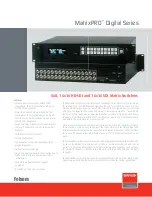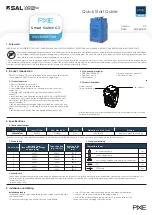
iv
P5417025-rev.1
● Do not perform installation work, refrigerant piping work, condensate pump, or condensate piping and
electrical wiring connection without referring to the installation manual. If the instructions are not followed,
it may result in a water leakage, electric shock or a fire.
● Use the specified non-flammable refrigerant (R410A) for the outdoor unit in the refrigerant cycle.
Charge only R410A into the unit. Do not charge other materials into the unit such as hydrocarbon
refrigerants (propane), oxygen, flammable gases (acetylene) or poisonous gases when installing,
maintaining and moving the unit. These flammables are extremely dangerous and may cause an
explosion, a fire, or injury. As originally manufactured, this unit contains refrigerant installed by the
manufacturer of the product. The manufacturer of the product uses only refrigerants that have been
approved for use in the unit’s intended country or market. Distributors similarly are only authorized
to provide refrigerants that have been approved for use in the countries or markets they serve. The
refrigerant used in this unit is identified on the unit’s faceplate and/or in the associated manuals. Any
additions of refrigerant into this unit must comply with the country’s requirements with regard to refrigerant
use and should be obtained from distributors. Use of unapproved refrigerant substitutes will void the
warranties and can cause injury or death.
● Do not pour water into the indoor or outdoor unit. These units are equipped with electrical parts.
Exposure to water may cause a serious electrical shock.
● Do not open the service cover or access panel for the indoor or outdoor units without turning OFF the main
power supply.
● Do not touch or adjust safety devices inside the indoor unit or outdoor units. If these devices are touched
or readjusted, it may cause a serious accident.
● Carefully check for escaping refrigerant gas. If there is significant leakage, it can cause difficulty in
breathing. Turn OFF the main switch, and contact your service contractor if refrigerant leakage occurs.
● Make sure that the refrigerant leakage test is performed.
Refrigerant (fluorocarbon) for this unit is incombustible, non-toxic and odorless.
However if the refrigerant is leaked and comes in contact with fire, toxic gas will generate.
Because fluorocarbon is heavier than air, the floor surface will be filled with it, which could cause
suffocation.
● The installer and system specialist shall secure against refrigerant leakage according to local regulations
or standards.
● Use a Earth Leakage Breaker (ELB).
In the event of fault, there is danger of an electric shock or a fire if it is not used.
DANGER
SAFETY SUMMARY
Summary of Contents for CH-AP04MSSX
Page 2: ......
Page 10: ...viii P5417025 rev 1 ...
Page 37: ...P5417025 rev 1 27 ...
Page 38: ...28 P5417025 rev 1 ...
Page 39: ...P5417025 rev 1 29 ...







































